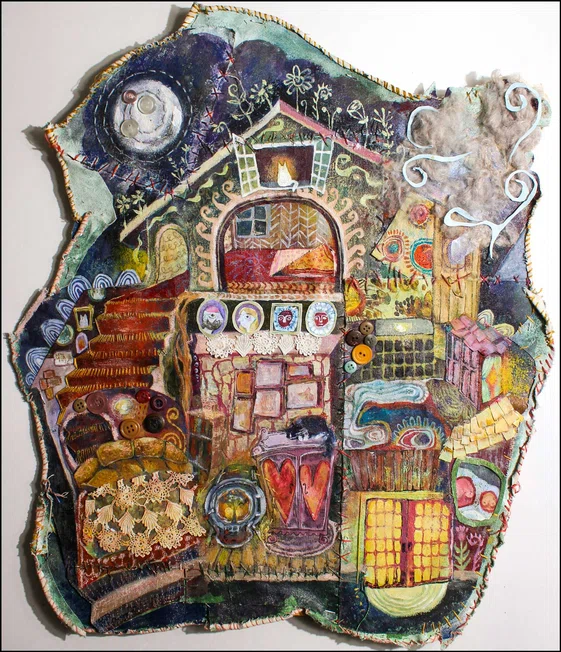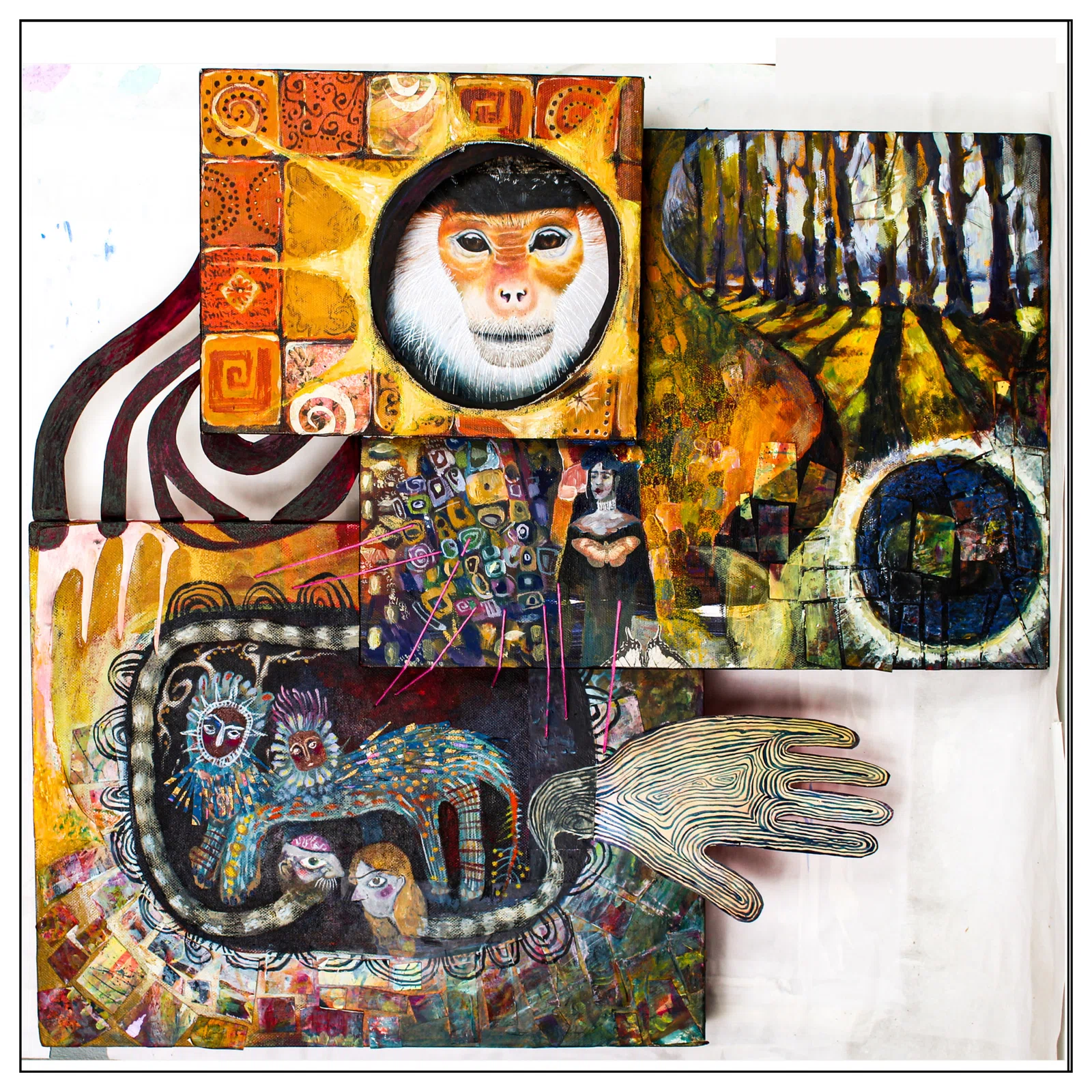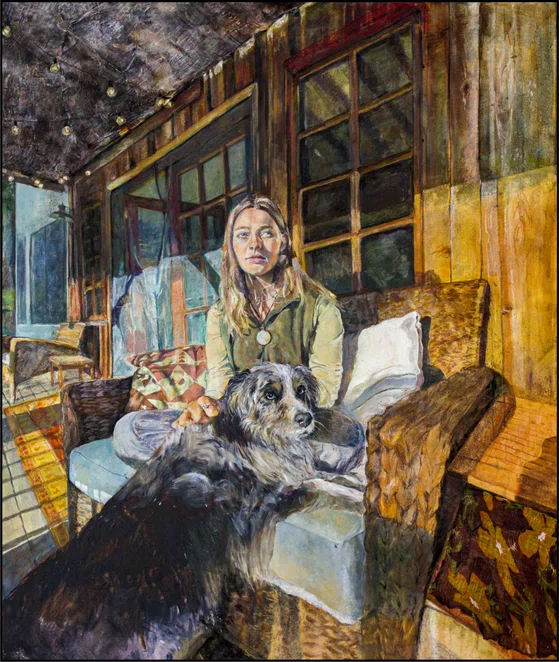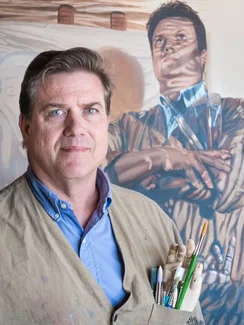







2-D Design
Islay Ross
Friday Harbor High School|Friday Harbor, Washington

Welcome Mat|22 x 18 in.
Material(s): Thread connects canvas patches, symbolizing my bond with home and creating unified Welcome Mat image
Process(es): Warm, inviting tones convey the comfort of home.Characterized patchwork quilt w/ childhood patterns.


“Guided by fear of being uprooted from my childhood home,I conveyed disruption by practicing abrasive textures & dissonant patterns”

Student statement
Student
statement
As a junior in high school who has lived on a tiny island my whole life, the idea of abandoning home after graduation is one that fills me with uncertainty. Developed under the pressure of choosing a college, my sustained investigation explores my internal conflict by posing the self-reflective question: how does fearing the unknown affect my experience in the face of major change?
My work conveys the complex nuances of transition in the context of the adolescent experience. I wanted to avoid painting change as a simple process by showing how hesitation, inspiration, uncertainty, nostalgia, internal conflict, and the thrill of adventure can all coexist during periods of transition. Ultimately, illustrating this complexity allowed me to look at my experience through a new lens of gratitude and acceptance.
Welcome Mat
Embracing the organic forms of unbound canvas, Welcome Mat is a patchwork quilt illustrating my childhood home. As I explored the source of my hesitation to leave my island community, I focused on why my connection to my home is so strong. To evoke a warm, inviting image of our wooden cabin, I synthesized materials traditionally associated with the comfort of home (buttons, thread, wool, yarn, lace) with imagery specific to my childhood (our Elm fireplace, stairwell, French doors, patterned carpet, old wood siding). I used elements of childlike imagination to evoke nostalgia and innocence, such as the flowers on the roof, the crayon-like textures, and the playfully exaggerated scale. Each unique canvas patch was hand-stitched together with my mom’s embroidery materials, further emphasizing familial connection and dependency. Illustrating my connection with my home allowed me to better navigate my complex emotional experience, as I was able to focus less on leaving home behind and more on my gratitude for my happy childhood memories.

Islay Ross

Welcome Mat process
New Moon Baby
New Moon Baby uses stacked canvases to represent the nature of growth. I drilled the canvas bars together into a rigid staircase form, then further unified them with layers of cut canvas, organic paper cutouts, and thread. Inspired by the storytelling imagery of folk art, the bottom tier shows a two-headed figure (my sister and me) encircled by a two-headed snake (our parents). The snake symbolizes a welcome shelter from the dissonance of the outside world and, simultaneously, the threshold into the unknown. In the second tier, the use of dark shadows, trees, mysterious figures, and abrasive Klimt-inspired patterns (made by rubbing pastels over paper cutouts) is meant to evoke uneasiness and mystery. The circular void, reminiscent of a new moon, is a reference to my origin- I was born on a new moon. The textural and emotional dissonance of the void is resolved when the monkey emerges through the cutout window in the canvas: wise, steady, and knowing. I was able to take my fear of leaving my family and create this piece as a reminder to myself that no matter what chaos lies ahead, I can always retrace my steps back to my roots: a staircase goes both ways.

New Moon Baby|22 x 18 in.
Material(s): Thread implies connection,canvas,acrylics,pastel, knife[creates windows],color pencils.
Process(es): Staircase structure suggests transition.Family life[bottom] to the unknown[trees]to contentment[top]
New Moon Process
Material(s): Childhood garden path mosaic texture[printed paper squares].Layered canvases for dynamic structure
Process(es): Practiced compositional layout of stacked canvases,developed conceptual symbols for family members
Rootbound
The title of Rootbound is a double entendre, referring to both the physical process of unifying the canvas with a rich, earthy sepia wash and the conceptual idea of a natural, grounding connection. The figure’s central compositional position suggests a steadfast belonging, and the exaggerated scale anchors her to her environment. Once again, there is an apprehension about the unknown: there seems to be some activity just outside of the bounds of the canvas that is obscured to the viewer. Both the figure and the dog’s eyes are focused on this mysterious external element, while the figure’s hesitant expression and grip on the dog’s collar suggest that the mystery is a source of anxiety. Despite this uneasiness, the mystery is also illustrated as something beautiful, a source of golden light that bathes the entire front porch in the sunshine. The complexity of my relationship with the unknown, both fearful and hopeful, is explored through a juxtaposition of emotional undertones, which works in combination with the massive scale to encapsulate the viewer.

Rootbound|72 x 60 in.
Material(s): Moms floral scarf.Rich earth tone wash enhances idea of natural habitat.Acrylic paint,oil pastels.
Process(es): Figures central position suggests steadfast belonging, offset eyes imply apprehension for the future.
New Moon Process
Material(s): Experimented w/textiles,creating texture by applying moms scarf with gesso[top left,bottom right]
Process(es): Sepia wash unifies color scheme, roots self-portrait to environment to depict my connection to home
Teacher Statement
Teacher Statement

"Sketchbooks are a place where kids practice, experiment, revise ... with materials, processes, and their ideas."
Andrew Anderson, Teacher
Listen to the teacher statement

Read the transcript
Hello, I'm Andrew Anderson, the art teacher at Friday Harbor High School in the beautiful San Juan Islands in the Pacific Northwest. And let me start by saying three minutes is not nearly enough time to get through all these prompts, but I will do my best. Some of the strategies that I use to guide my students to the inquiry start in the summer, with mind mapping, and watching AP Daily videos. Generating potential ideas for their inquiry, it's important to stress, you know, the personal experience. I find that they are more vested if it's being drawn from personal experience, which will carry them through the year.
Hello, I'm Andrew Anderson, the art teacher at Friday Harbor High School in the beautiful San Juan Islands in the Pacific Northwest. And let me start by saying three minutes is not nearly enough time to get through all these prompts, but I will do my best. Some of the strategies that I use to guide my students to the inquiry start in the summer, with mind mapping and watching AP Daily videos. In generating potential ideas for their inquiry, it's important to stress the personal experience. I find that they are more vested if it's being drawn from personal experience, which will carry them through the year.
Writing also plays a large role in my class, and we're constantly writing. Writing about what we practiced, what we experimented with, and what we revised. What's working, what's not working, and how are the materials going? All these things we write about, we also put together and edit. They may do 12 to 15 drafts before they submit their inquiry statement into their digital portfolio. So, it's a big part of what we do.
Those are some of the things that we do here in Friday Harbor, and I hope that is informative.As far as supporting development in skills, I would say to the kids skills are a lifelong process. It takes time. It's not something that happens overnight. I usually give them advice on different techniques and different materials, and we watch YouTube videos. But, it's important to stress that you have to be diligent, that you have to be patient, that you have to, you know, work through that process.
How do I structure, approach, experimentation, and revision in the class? A big part of that is in sketchbooks. Sketchbooks are a place where kids practice and experiment and revise with materials, processes, and ideas. We do them before we start a piece, and we do them during a piece. So, sketchbooks play a big part. Oftentimes those students will revise pieces—they'll go back in after reflecting and rework pieces—so that's another thing that students do.
Formative and summative assessment. I'm constantly doing formative assessments, walking around the room, talking to students, and asking them questions. Our summative assessment can be written but is also in the classroom critiques where students discuss their work. I think it's really important to create a culture where students feel comfortable and confident to talk about what they're doing and also to give advice.
As far as creative programming, spaces, mentoring, and all those types of things ... This school has been amazing. They allow us to put our work in the hallways, the library, and the common room. They've provided mats and frames. We show work in the community theater and our businesses around town, and we also have an Alchemy Program where artists from the community created space and place for students to work with professional artists on glassblowing, photography, ceramics, all kinds of things—which is really unique in such a small place.
What I've learned from working with Islay Ross is, first, she's just an amazing student. She is intellectually curious and hardworking. She's a person who sees connections that others don't often see. I am so proud of her, and I'm so confident that she's going to go on to just do amazing things in her future.
Some advice that I would give to AP teachers is at least one time in your career, go to the AP reading and participate in that. It is the best professional development I've ever done. The teachers, art teachers from all over the country, they're just phenomenal. They've become my friends. They're people that I rely on, and that I communicate with throughout the year when I have questions or concerns. It's just an amazing network of people.

Islay Ross














